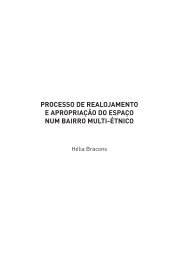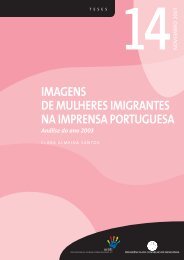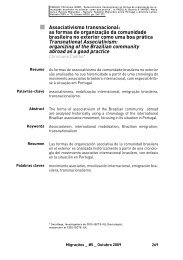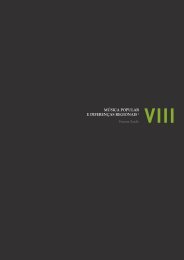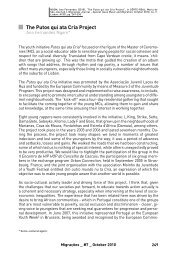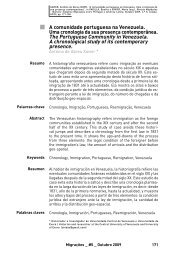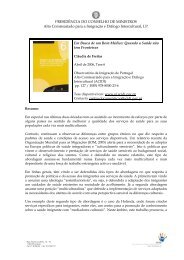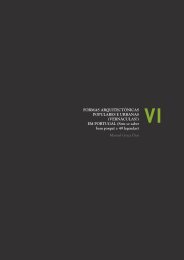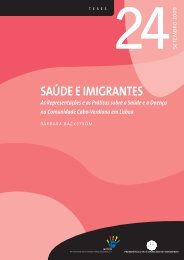Revising citizenship: migration and fado in the play of identities in ...
Revising citizenship: migration and fado in the play of identities in ...
Revising citizenship: migration and fado in the play of identities in ...
Create successful ePaper yourself
Turn your PDF publications into a flip-book with our unique Google optimized e-Paper software.
As usual, <strong>the</strong> d<strong>in</strong>ner was served to <strong>the</strong> sound <strong>of</strong> music – <strong>of</strong> a homem orquestra 4 , ono<strong>the</strong>r occasions a conjunto 5 . At about 11p.m., <strong>the</strong> fadista <strong>and</strong> musicians 6 appeared,<strong>and</strong> <strong>the</strong> room fall silent, <strong>the</strong> first <strong>fado</strong> session took place. There were usually three <strong>of</strong>about 30’ each. Songs <strong>of</strong> sorrow, sadness, disappo<strong>in</strong>tment, jealousy, nostalgic nature<strong>of</strong> <strong>fado</strong> <strong>and</strong> poor ambience <strong>of</strong> ancient Lisbon were sung to <strong>the</strong> accompaniment <strong>of</strong> <strong>the</strong>guitar <strong>and</strong> <strong>the</strong> Portuguese guitar. The vocal style was as close as possible to a modelselected from pre-migrant memory. At <strong>the</strong> end <strong>of</strong> <strong>the</strong> session, <strong>fado</strong> performers left <strong>the</strong>“stage” space, without any k<strong>in</strong>d <strong>of</strong> raised platform, or even <strong>the</strong> room, <strong>and</strong> dance musicfollowed. With it, <strong>and</strong> suddenly, <strong>the</strong> atmosphere exchanged radically. The audiencedanced, laughed <strong>and</strong> spoke loud. The unstressed ambience called for participation.Lambada reigned with all its exuberance. Eventually some o<strong>the</strong>r Lat<strong>in</strong> American hits<strong>and</strong> one or two items <strong>of</strong> Portuguese popular music made <strong>the</strong>ir way before ano<strong>the</strong>rlambada rendition, tirelessly repeated all night long. The danc<strong>in</strong>g periods lasted longerthan those <strong>of</strong> <strong>fado</strong>, about 50’ each. Dance <strong>and</strong> <strong>fado</strong> alternated as though after mak<strong>in</strong>g itthrough a tense session, a time <strong>of</strong> release was vital to cont<strong>in</strong>u<strong>in</strong>g with <strong>the</strong> event.The announcement, as usual, had been for a Gr<strong>and</strong>e Noite de Fados <strong>and</strong> all staged attentionseemed to concentrate on it. However, <strong>the</strong> night was clearly composed <strong>of</strong> twodifferent <strong>and</strong> apparently <strong>in</strong>dependent parts. The most participated <strong>and</strong> animated was<strong>the</strong> least valued. A somewhat related model <strong>of</strong> performance was <strong>the</strong>n observable,<strong>and</strong> still rema<strong>in</strong>s, <strong>in</strong> Lisbon, where <strong>in</strong> some Casas de Fado (restaurants called Houses<strong>of</strong> Fado) <strong>fado</strong> sessions are <strong>in</strong>terwoven with staged moments <strong>of</strong> folklore dance. In Lisbon,however, <strong>the</strong> audience did not participate. Most clients <strong>in</strong> <strong>the</strong> restaurants visited<strong>in</strong> <strong>the</strong> summer <strong>of</strong> 1990 were tourists, ei<strong>the</strong>r non-nationals or from o<strong>the</strong>r regions <strong>of</strong>Portugal, much less engaged <strong>in</strong> <strong>the</strong> performance than <strong>the</strong> US counterparts.My study <strong>the</strong>n led me to disregard <strong>the</strong> danc<strong>in</strong>g <strong>in</strong>termissions between <strong>the</strong> <strong>fado</strong> sessions.Caught up by <strong>the</strong> relaxed ambience <strong>of</strong> <strong>the</strong> dance sessions, I capitalised on<strong>the</strong>m as <strong>in</strong>terview<strong>in</strong>g time. It was dur<strong>in</strong>g <strong>the</strong>se highly participative moments <strong>of</strong> <strong>in</strong>tensivebody reaction that I collected <strong>the</strong> comparatively <strong>in</strong>tensive m<strong>in</strong>d reactions <strong>of</strong> <strong>the</strong>participants regard<strong>in</strong>g <strong>the</strong> <strong>in</strong>terpretation whe<strong>the</strong>r <strong>of</strong> <strong>the</strong>ir own <strong>fado</strong> performances orthat <strong>of</strong> o<strong>the</strong>rs. As <strong>the</strong> focus <strong>of</strong> my study was established on <strong>the</strong> retention <strong>of</strong> musicalmodels <strong>in</strong> performance, my aims proved <strong>in</strong> tune with those declared by participants.My attitude <strong>of</strong> overlook<strong>in</strong>g <strong>the</strong> dance sessions seemed even welcome. The fieldworkstrategy entailed two aspects: on <strong>the</strong> one h<strong>and</strong>, my observation <strong>of</strong> <strong>the</strong> unstressedmoments <strong>of</strong> body priority was <strong>in</strong>terrupted by <strong>the</strong> lead<strong>in</strong>g research <strong>in</strong>terest <strong>in</strong> <strong>the</strong>event’s <strong>of</strong>ficially advertised product, <strong>fado</strong>; on <strong>the</strong> o<strong>the</strong>r h<strong>and</strong>, my <strong>in</strong>terviews, seek<strong>in</strong>g<strong>in</strong>tellectual response, clearly pr<strong>of</strong>ited from <strong>the</strong> relaxed ambience. The paradoxicalsituation <strong>in</strong> <strong>the</strong>se <strong>in</strong>termissions, when relaxed <strong>in</strong>formants tried to produce controlledanalytical descriptions <strong>of</strong> <strong>the</strong>ir own music behaviour, may have had some effecton <strong>the</strong> unexpected responses some answers revealed regard<strong>in</strong>g <strong>the</strong> motivation toperform <strong>fado</strong> <strong>and</strong> even <strong>the</strong> susta<strong>in</strong>ability <strong>of</strong> that form <strong>of</strong> representation <strong>of</strong> <strong>the</strong>ir Portuguese<strong>citizenship</strong>. Resonances <strong>of</strong> this ambivalence, nurtured by subsequent studieson cultural policy, musical expression <strong>and</strong> categorization dur<strong>in</strong>g <strong>the</strong> dictatorship <strong>in</strong>Portugal (Côrte-Real, 2000), renew<strong>in</strong>g my <strong>in</strong>terest on <strong>the</strong> reflection about <strong>fado</strong> performance<strong>in</strong> <strong>the</strong> migrant context, provided me with <strong>the</strong> foundations for this article on<strong>the</strong> <strong>in</strong>terpretation <strong>of</strong> <strong>citizenship</strong> representation.76 Music <strong>and</strong> Migration



